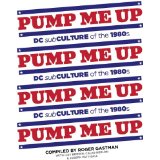Pump Me Up – DC subCulture of the 1980s – Roger Gastman
R. Rock Enterprises www.rrockenterprises.com/Gingko Press, Hamburger Str. 180, 22083 Hamburg, www.gingkopress.com
While this book takes you back in time for real, it also leaves me with mixed feelings, let me tell you why, before I give you a overview. It is always great to look at old photos, flyers, cover, etc. of D.C. punk/hardcore history and read interviews with some of „the“ protagonists, especially in this case since the conversations also spin off in the direction of the book, D.C. politics, and the „other“ D.C./Go-Go. That part about the Go-Go is definitly interesting, and very authentic. Unfortunally there is not much content, apart from „getting your name up and get known“ and „have fun at the Go-Go’s“ – which is fine.
But unnecessary to cover it in such a dimension. Who needs to see dozens of photos of always the same – yes, legible – graffiti/name written on various walls? And while everybody claims that D.C. crews are not gangs – I dont really see a big difference, which gets proofed by the statements of the below mentioned gangsters, I mean crewsters…… This might be a long shot, but I have the feeling the authors have a problem to criticize anything that is „the other“ D.C., (in fear of beeing called racist?) which might be understandable if one lifes in the city, but in the end makes not much sense. Sure, you can call a bunch of people who organise Go-Go’s, make music, sell and use drugs, start fights, carry guns, scrawl their name all over the city in order to „get their name up“ (not necessarly all of this together!) a culture. But you can also call it what it is.
In the beginning there is three chapters: Background, Foreword and Introduction – the author tells about how this project started and how it went over the years, followed by a text from Sarah Newman where she explains that „Pump Me Up explores the landscape and the culture of this period – Go-Go, graffiti, punk, hardcore, graphic design, fine art and the heady relationships between them.“ Then Gastman and Caleb Neelon go back in the narrative (to the 50/60s) of Washington D.C. and explain why there is „two washingtons“ (black and white), write about the riots that followed Martin Luther Kings shooting, political issues – all pretty interesting.
As is the interview with Walter Fauntroy – a civil rights activist (and pastor…) who organised, amongst other things, the Voting Rights March in the mid 60s and now talks about the history of D.C., crack, building policy, etc. „Homelessness“ is the topic of the next short chapter, followed by a interview with Ian MacKaye. Jon Lewis introduces us to Globe Posters, who where a force in printing posters for the Go-Go events. Trina Calderón presents the 9:30 club and his history followed by a interview she conducted with Cynthia Connolly. Gastman and Neelon write about D.C. Crews and what diffrences them from gangs (it can be a language thing, like one says its a „Semmel“ not a „Brötchen“ but means the same thing, in that case I wish it would have been explained….). Love Boat/PCP and the murder of Catherine Fuller are the next subjects – very terrible.
The next +40 pages are dedicated to Danny Hogg aka Cool „Disco“ Dan who’s single life accomplishment was to tag his name all over the city (and to stay away from drugs), everywhere, for very many years. And you need to know that „The Washington D.C. tags were meant to be legible, a symbol of someone’s presence rather than artistic talent…“ that is understandable, but I question why such scribble needs to be gloryfied in this dimension. You learn everything about the life of this guy from the cradle to the present. Next up to be questioned is Jeff Nelson. Then Neelon writes about the crack scourge suitable followed by the story of Marion Barry, D.C.s longyear mayor who is, outside of D.C., mainly known for getting busted for coke….. but he also did so much good for the city and the youth. We now enter the Go-Go scene, starting off with their pioneers, by Alona Wartofsky, who also explains us the history of that „Sound of the City“. Intersting.
Next up is a interview with the godfather of Go-Go – Chuck Brown. Joseph Pattisall talks to Sugar Bear and then to Wink from the Yunk Yard Band. Hip Hop, Dancers, Trouble Funk, Rare Essence are a few other articles/interviews. After this it is getting real authentic when people like Kenny Ball (Notorious Knock Out Artist), Tonya F („I had to kick a bitch’s ass about three weeks ago! I’m still going hard. I’m still demanding my respect out here.“), RE Randy (inmate for life, gun possession, murder), Andrew Wood („…street-level heroin selling. Which earned him 187 months of Federal prison in the fall of 1989.“), Gangster George (from the crew Ganster Chronicles) and Lisa of the World (from the female crew Lady Chronicle) are interviewed by diverse people.
A big jump to the other side, Robin Rose who „established himself in D.C.’s evolving creative scene as a fine artist and musician with the band Urban Verbs.“ talks about how he experienced his time in D.C. Mark Jenkins (co founder Postive Force D.C.) is up next to talk about Punk Rock and HarDCore. At the end Rayful Edmond III (high level drug dealer) is introduced and you learn there is also a traditional graffiti scene in D.C. The +300 pages (3 x 22 x 28,8 cm, 1,8 kg, hardcover) are fatly illustrated with hundreds of photos, posters, flyers and other memorabilia. So there is plenty to look at. Authentic book, (over) documents a true culture of D.C. at that time and is certainly good to start a discussion. 44,95 US $ (dolf)
Isbn 978-1584235132
[Trust # 162 October 2013]
